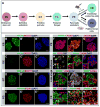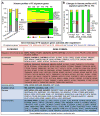Dynamic chromatin remodeling mediated by polycomb proteins orchestrates pancreatic differentiation of human embryonic stem cells
- PMID: 23318056
- PMCID: PMC3619036
- DOI: 10.1016/j.stem.2012.11.023
Dynamic chromatin remodeling mediated by polycomb proteins orchestrates pancreatic differentiation of human embryonic stem cells
Abstract
Embryonic development is characterized by dynamic changes in gene expression, yet the role of chromatin remodeling in these cellular transitions remains elusive. To address this question, we profiled the transcriptome and select chromatin modifications at defined stages during pancreatic endocrine differentiation of human embryonic stem cells. We identify removal of Polycomb group (PcG)-mediated repression on stage-specific genes as a key mechanism for the induction of developmental regulators. Furthermore, we discover that silencing of transitory genes during lineage progression associates with reinstatement of PcG-dependent repression. Significantly, in vivo- but not in vitro-differentiated endocrine cells exhibit close similarity to primary human islets in regard to transcriptome and chromatin structure. We further demonstrate that endocrine cells produced in vitro do not fully eliminate PcG-mediated repression on endocrine-specific genes, probably contributing to their malfunction. These studies reveal dynamic chromatin remodeling during developmental lineage progression and identify possible strategies for improving cell differentiation in culture.
Copyright © 2013 Elsevier Inc. All rights reserved.
Figures







References
-
- Apelqvist A, Li H, Sommer L, Beatus P, Anderson DJ, Honjo T, Hrabe de Angelis M, Lendahl U, Edlund H. Notch signalling controls pancreatic cell differentiation. Nature. 1999;400:877–881. - PubMed
-
- Bernstein BE, Mikkelsen TS, Xie X, Kamal M, Huebert DJ, Cuff J, Fry B, Meissner A, Wernig M, Plath K, et al. A bivalent chromatin structure marks key developmental genes in embryonic stem cells. Cell. 2006;125:315–326. - PubMed
-
- Boyer LA, Plath K, Zeitlinger J, Brambrink T, Medeiros LA, Lee TI, Levine SS, Wernig M, Tajonar A, Ray MK, et al. Polycomb complexes repress developmental regulators in murine embryonic stem cells. Nature. 2006;441:349–353. - PubMed
Publication types
MeSH terms
Substances
Grants and funding
LinkOut - more resources
Full Text Sources
Other Literature Sources
Molecular Biology Databases

